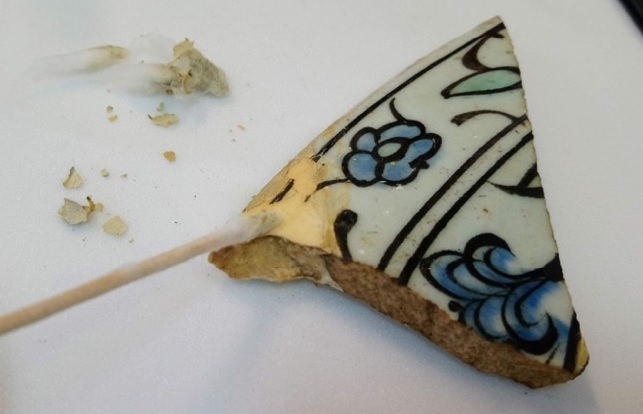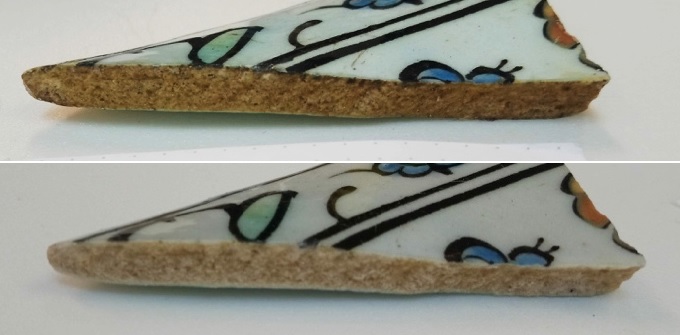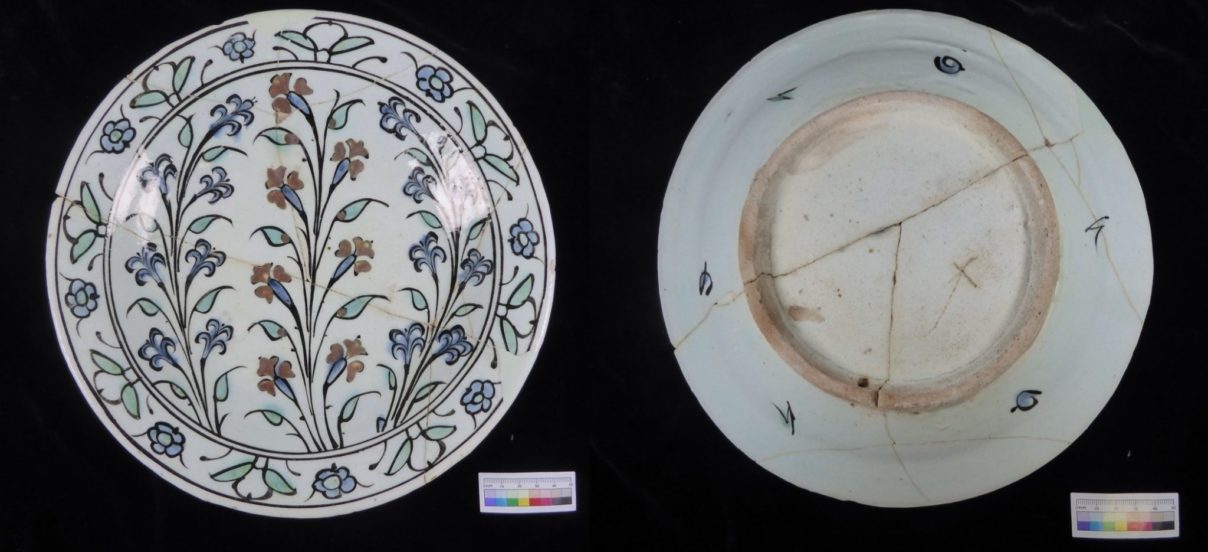February ’20
Iznik Dish
February’s ‘Object of the Month’ is a decorative Iznik dish from the Oriental Museum.

The object is a ceramic dish with a slightly raised wide-flaring rim, decorated and glazed with green, blue, black and red ornaments. The ceramic body is cream coloured with a bluish-white slip, hand painted floral motifs and a transparent glaze. One long stem of red flowers, possibly carnations, runs through the middle of the dish, with blue hyacinth stems on either side. The rim of the dish is decorated with alternating prunus blossoms and green flower buds. The backside of the rim has six small simplistic decorations of curls and lines.

Iznik pottery is a type of glazed ceramic produced during the height of the Ottoman Empire, named after the town Iznik, where this ceramic originated. Elaborate curved floral patterns in blue, green and red on a white background defines the style of Iznik ceramics. The style, colours and manufacturing method of Iznik ware were a significant innovation in the ceramic industry and made the pottery world-renowned. The production quality of Iznik pottery reduced significantly by the mid-17th Century and is linked to the steady decline of the Ottoman Empire. Decorations became less elaborate and more specifically the red coloured decorations became darker and less vibrant. The dish in question has a very simplistic motif and a significantly darker and more ‘dull’ red decoration than early examples of Iznik pottery, which puts its dating around late 17th century.

A large export city for trading Iznik pottery was Cairo, which is where this dish was purchased in 1957/58 by John Alden Williams. After breaking, it was conserved in the 1960’s in Oxford; the treatment residues probably originate from this treatment. The dish was donated to the Oriental Museum in 2019 by Caroline Williams and is to be displayed in the museum’s upcoming permanent display about the Silk Road.
Conservation

Cleaning off the previous fills and adhesive was done using both solvent and mechanical cleaning. Acetone was used first with cotton wool swabs in order to remove the old fills and adhesive. The remaining plaster from the fills was then removed using a scalpel.

One small sherd was still joined to another with the old adhesive. To disassemble this join, cotton wool soaked in acetone was placed on both sides of the join. The area was then covered in aluminium foil to slow the evaporation process. Adding acetone to the cotton wool every 10 minutes with a pipette, the adhesive was softened enough after 30 minutes to easily take apart the join.
The staining on the edges of the ceramic pieces was removed using immersive cleaning. The ceramic sherds were placed into a solution containing sodium hexametaphosphate and checked every four hours to monitor changes. On final removal they were rinsed using deionised water and allowed to dry.

To restore the appearance and aesthetic value of the dish, the sherds were re-adhered using Paraloid B-72. Before adhering the sherds, the breaks were coated with a thin layer of 6% Paraloid B-72 in acetone, this strengthened the friable ceramic body and ensuring the adhesive had enough surface area to cover. Then, each sherd was adhered, using a pre-planned order to make sure no sherds were locked out.

Two noticeable gaps at the edge, where the cream-coloured body is visible, were disruptive to the shape and pattern of the dish. The locations of the fills were also adjacent to the points where the dish could be supported during display. It was therefore decided to fill these two gaps with Plaster of Paris. To cast the fill, a one-sided mould was taken of the intact edge with heated dental wax, secured at the gaps with Scotch tape. The plaster was applied to the mould and left to harden for about 20 minutes, before removing the mould and carefully trimming the fill using a scalpel. When the plaster had fully hardened, it was sanded with fine sandpaper to create a smooth finish. As Plaster of Paris has a bright white colour, it would accentuate the fills and distract the viewer. To avoid this, the fills were painted with acrylic pigments to match the bluish-white colour of the glazed surface.

Stay tuned for next month’s object!
